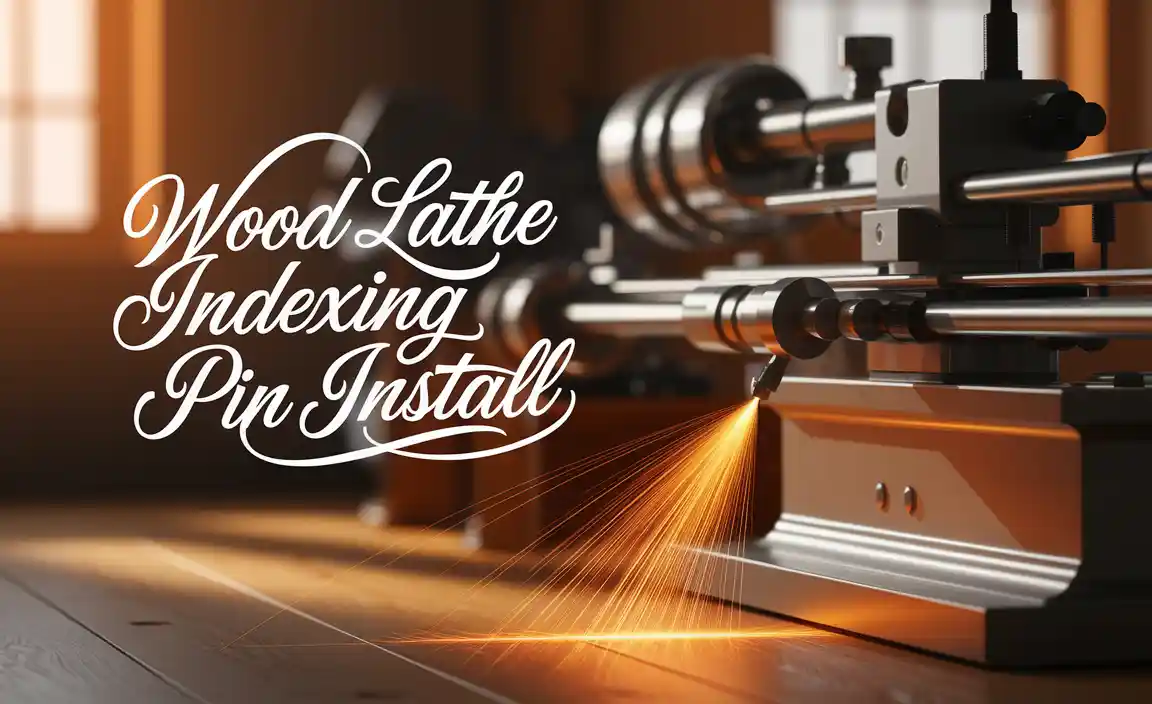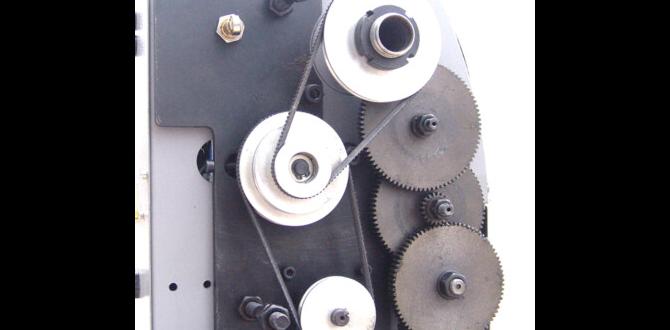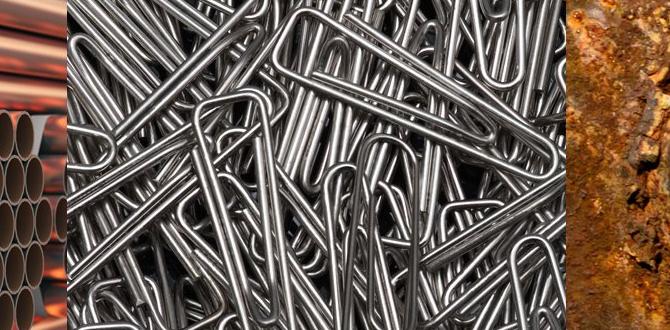Quick Summary:
To minimize deflection with a carbide end mill on A2 tool steel, use a rigid setup, the right cutting parameters (lower speeds, higher feed rates), and consider specialized end mill geometries. This guide provides proven techniques to keep your cuts accurate and your tools performing reliably.
Carbide end mills are fantastic for cutting tough materials like A2 tool steel, but sometimes they can bend a little, especially when you’re just starting out. This bending, called deflection, can mess up the accuracy of your cuts. Don’t worry, it’s a common hiccup, and with a few simple tricks, you can get those precise results you’re aiming for. We’ll go through how to keep your end mill steady and your workpiece looking just right, step by step.
Why Does Deflection Happen with Carbide End Mills?
Deflection is basically a tool bending under pressure. When your carbide end mill is cutting into A2 tool steel, the forces involved can push and pull on the tool. If these forces are stronger than the tool’s resistance to bending, it will deflect. Think of it like trying to push a stiff straw sideways – it might hold its shape, but push hard enough, and it will bend.
There are a few main reasons why this happens, especially for beginners working with A2 steel:
- Cutting Forces: The act of removing material generates significant forces. A2 steel is hard, so these forces are amplified.
- Tool Stick-out: The longer the end mill sticks out from the collet or holder, the more leverage there is to cause bending.
- Machine Rigidity: A less rigid machine, or worn components, can allow more movement, leading to perceived deflection.
- Improper Cutting Parameters: Using speeds and feeds that are too aggressive or not suited for the material and tool can increase cutting forces and cause deflection.
- Tool Geometry: The design of the end mill itself (number of flutes, helix angle, etc.) plays a role in how it handles cutting forces.
For A2 tool steel, a material known for its hardness and toughness (especially after heat treatment), these forces can be substantial. This means controlling deflection is extra important to achieve accurate dimensions and a good surface finish without breaking your tool.
Choosing the Right Carbide End Mill
Not all carbide end mills are created equal, especially when you’re tackling something like A2 tool steel. For beginners, selecting the right tool can make a world of difference in managing deflection.
Key Features to Look For:
- Material: Ensure it’s a high-quality solid carbide end mill designed for hardened steels.
- Coating: A good coating, like TiAlN (Titanium Aluminum Nitride) or AlTiN (Aluminum Titanium Nitride), can improve performance and heat resistance, allowing for slightly more aggressive cutting without premature tool failure.
- Number of Flutes: This is crucial. For harder materials like A2 steel, a higher number of flutes (like 4 or 5) can provide better surface finish and chip evacuation. However, more flutes mean less chip room, so you might need to adjust your feed rate. For general-purpose milling on A2, a 4-flute end mill is often a good starting point.
- Helix Angle: A steeper helix angle (e.g., 30-35 degrees) generally provides a better cut and can reduce chatter, which is often linked to deflection.
- End Type: Standard square end mills are common. For slotting or creating square pockets, they are essential. Ball-nose end mills create rounded features, and corner radii end mills help reduce stress at the corner by providing a small radius.
Recommended End Mill Specifications for A2 Steel (Beginner Focus):
For common beginner projects on A2 tool steel, you’ll likely be using smaller diameter end mills. Here are some typical specs:
| Size | Shank Diameter | Flutes | Coating | Purpose |
|---|---|---|---|---|
| 1/8″ Diameter | 1/8″ | 4 | TiAlN or AlTiN | Detail work, small pockets, light contouring |
| 1/4″ Diameter | 1/4″ | 4 | TiAlN or AlTiN | General milling, pockets, profiling |
When buying, look for terms like “high-performance,” “for hardened steels,” or “for aerospace alloys.” These usually indicate a tool designed to handle tougher jobs. For instance, selecting a “carbide end mill 1/8 inch 1/4 shank standard length for tool steel A2″ focuses on the critical parameters you’ll need.
Achieving a Rigid Setup
A rigid setup is your first line of defense against deflection. If your tool, workpiece, or machine can move, deflection is almost guaranteed. Think about securing everything as firmly as possible.
Workpiece Fixturing:
The way you hold your A2 steel part is critical.
- Vises: Use a good quality, sturdy vise. Ensure the jaws are clean and provide even clamping pressure. For critical parts, consider using soft jaws to avoid marring the steel and to distribute clamping force better.
- Clamps: If you’re bolting the workpiece directly to the machine table, use sturdy clamps and strap clamps. Make sure the clamps are positioned to provide support and don’t interfere with the cutting path.
- Supports: For longer or thinner parts, use support blocks or jacks underneath to prevent the workpiece from lifting or deflecting away from the cutting forces.
Tool Holder and Collet:
The connection between your end mill and the milling machine spindle is another prime spot for rigidity issues.
- Collet Chucks: These are significantly more rigid than a typical drill chuck for milling. Ensure your collet is the correct size for your end mill shank and is clean. A well-maintained R8 or CAT 50 collet system provides excellent concentricity and grip.
- Stick-out: This is a HUGE factor. The less the end mill sticks out of the collet or holder, the less it can deflect. Aim to have the shortest possible flute length exposed during cutting. For example, if you need to cut to a depth of 0.5 inches, try to use an end mill that has at least 1 inch of flute length, and set it so only the necessary amount is exposed.
- Cleanliness: Always ensure your collets and tool holders are clean. Any debris can prevent proper seating and reduce rigidity.
Machine Rigidity:
While you can’t always change your machine, understanding its limitations helps.
- Table and Knee: Make sure the table locks and knee locks are engaged when you’re performing cuts where side forces are significant.
- Spindle Bearings: Worn spindle bearings can introduce play, leading to deflection. Regular maintenance is key.
Optimizing Cutting Parameters for Deflection Control
Once your setup is rigid, the next major area to control deflection is through your cutting parameters – specifically, your spindle speed and feed rate. This is where many beginners struggle, often relying on generic recommendations.
Understanding Speeds and Feeds in A2 Steel:
A2 tool steel is hard and abrasive, meaning it requires slower spindle speeds and often higher, more consistent feed rates than softer materials like aluminum.
- Spindle Speed (RPM): Generally, you’ll want to run slower RPMs when milling hardened A2 steel. This reduces the heat generated and the shock load on the cutting edge.
- Feed Rate: This is the speed at which the tool moves through the material. For deflection control, you want to establish a consistent, healthy chip load – the thickness of the material being removed by each cutting edge (flute) of the end mill. A consistent chip load helps the tool cut efficiently and reduces the tendency for the edges to rub or chatter, which exacerbates deflection. Sometimes, this means a higher feed rate than you might expect for softer materials.
Deflection-Specific Strategies:
- Backlash Compensation: If your machine has manual backlash compensation, use it. This helps account for any play in the lead screws.
- Stepover and Depth of Cut: These are critical when dealing with deflection.
- Shallow Depth of Cut: Taking shallower cuts means less material is being engaged at once, significantly reducing the cutting forces and thus deflection.
- Smaller Stepover: Similar to depth of cut, a smaller radial stepover (how much of the end mill’s diameter engages the material sideways) also reduces radial cutting forces.
- Climb Milling vs. Conventional Milling:
- Conventional Milling: The cutter rotates against the direction of feed. It tends to lift the cutter, which can sometimes ‘fight’ against deflection but can also lead to chatter.
- Climb Milling: The cutter rotates in the same direction as the feed. This pulls the cutter into the material, creating a more consistent chip load and generally leading to a better surface finish. Climb milling can be excellent for controlling deflection because it inherently pushes the workpiece against the cutter and reduces upward forces. However, it requires a rigid setup and can be more prone to chatter if not set up correctly. For beginners focused on deflection, often starting with conventional milling in specific areas is safer, but for pure deflection control when rigid, climb milling is powerful.
- “Peck” Drilling or “Helical Interpolation”: If you need to create a hole or internal pocket, use a plunging tool path. Start by plunging (drilling down), then engage the side milling. For deep pockets, consider “pecking” – plung, mill a bit, retract, plunge again. This helps evacuate chips and reduce heat. Helical interpolation is also very effective for creating holes.
Feeds & Speeds – A Starting Point for A2 Tool Steel (for a 1/4″ 4-Flute Carbide End Mill):
These are starting points and will vary based on your specific machine, the exact hardness of your A2 steel, and the coolant used. Always listen to your machine and adjust!
Generally, for A2 steel, you’ll be looking at:
- Spindle Speed (RPM): 150 – 400 RPM
- Feed Rate per Tooth: 0.001″ – 0.003″ (This is the chip load. Multiply this by the number of flutes to get your calculated feed rate in inches per minute: e.g., 0.002″ per tooth 4 flutes = 0.008″ per minute feed your spindle speed RPM). This is a very conservative starting point. You may be able to push faster.
- Depth of Cut (DOC): 0.010″ – 0.050″ (Very shallow initially. Adjust based on rigidity and tool strength.)
- Stepover (Radial Depth): 10% – 30% of tool diameter (e.g., 0.025″ – 0.075″ for a 1/4″ end mill).
Always refer to manufacturer recommendations for tooling. Companies like OSG or Ingersoll Cutting Tools provide excellent resources for speeds and feeds.
Advanced Techniques and Tooling Considerations
While the basics of rigidity and parameter control will get you far, there are even more advanced ways to tackle deflection in A2 steel.
Specialized End Mill Geometries:
Beyond standard square end mills, some designs are inherently better at reducing deflection and chatter:
- Variable Helix and Variable Pitch End Mills: These tools have flutes that are ground with alternating helix angles or pitches. This helps to break up resonant frequencies that cause chatter and vibration, leading to more stable cutting and less deflection.
- Core-Drill / Conical End Mills: Some end mills have a slight taper or a reinforced core, which can increase their rigidity.
- Crush-Ground or Form-Relieved End Mills: These are often higher quality and offer better performance, but are usually more expensive and less common for beginner hobbyist use.
Coolant and Lubrication:
Proper coolant and lubrication are essential when working with hardened steels like A2. They:
- Reduce Heat: Excessive heat can degrade carbide, leading to premature failure and increased deflection.
- Lubricate: This reduces friction, allowing the tool to cut more smoothly and with less force.
- Flush Chips: Good chip evacuation is critical. Clogged flutes can lead to rub, heat, and deflection.
For A2 steel, a good quality synthetic coolant or a semi-synthetic through-spindle coolant system is highly recommended if possible. For manual machines, misting systems or even light oil lubrication can help.
Roughing vs. Finishing Passes:
It’s often beneficial to break down your milling operation into at least two passes:
- Roughing Pass: Use more aggressive parameters (within reason) to remove the bulk of the material. This pass might allow for a bit more acceptable deflection.
- Finishing Pass: Take a very shallow pass (e.g., 0.005″ – 0.010″ depth of cut) with a slower feed rate to achieve the final dimensions and surface finish. This finish pass is where you can truly achieve high accuracy because the cutting forces are minimal, and any remaining deflection has a much smaller impact.
Troubleshooting Deflection Issues
Even with the best intentions, you might encounter deflection. Here’s how to diagnose and fix common problems.
Symptoms of Deflection:
- Oversized Cuts: The final part is larger than intended, especially in areas where the tool was doing heavy side milling.
- Poor Surface Finish: Scalloping, chatter marks, or a generally rough surface.
- Tool Breakage: Constant tool breakage, especially on the side of the cut.
- Inaccurate Pockets/Slots: Internal features are larger than specified.
- Part Geometry Distortion: Thin walls bowing out or in.
Common Problems and Solutions:
| Problem | Possible Cause | Solution |
|---|---|---|
| Oversized slot or pocket | Tool deflection during cut | Reduce depth of cut, reduce stepover, increase rigidity of setup, use climb milling if possible. Ensure workpiece is rigidly held. |
| Excessive chatter or vibration | Machine rigidity, unbalanced tool/holder, incorrect speeds/feeds, tool not sharp enough. | Improve setup rigidity, check tool balance, adjust RPM/feed for a stable chip load, use a carbide end mill suited for A2. Shorten tool stick-out. |
| Tool rubbing instead of cutting | Feed rate too low, dull tool, shallow depth of cut producing adiabatic chips. | Increase feed rate to achieve proper chip load. Sharpen or replace tool. Increase depth of cut slightly if rigidity allows. |
| Tool breakage on side of cut | Excessive radial force, hitting material too hard. | Reduce stepover significantly, consider a tool with fewer flutes (e.g., 2-flute for slotting if deflection is severe, though 4-flute is preferred for finish), take lighter finishing passes. |
| Poor surface finish in corners | Tool deflection rounding off the corner, tool rubbing. | Use a corner radius end mill if the design allows. Take a lighter finishing pass. Ensure proper chip evacuation. |
Frequently Asked Questions (FAQ) about Carbide End Mills and A2 Steel
Q1: What is the biggest mistake beginners make when milling A2 steel with a carbide end mill?
The biggest mistake is often not having a rigid enough setup or not understanding that A2 is a tough material requiring deliberate parameter settings. Beginners might try to use the same settings as for softer metals, leading to deflection and tool breakage.
Q2: How much should the end mill stick out from the collet?
As little as possible! For a 1/4″ end mill, ideally, you want the cutting portion to extend no more than 3/4″ to 1″ from the collet. The more it sticks out, the more it acts like a spring and deflects.
Q3: Should I use a 2-flute or 4-flute end mill for A2 steel?
For general milling of A2, a 4-flute end mill is usually preferred for a better surface finish and to achieve higher feed rates when needed. However, for deep slots where chip evacuation is a major issue and rigidity is a concern, a 2-flute end mill can sometimes be better as it offers more chip room, allowing for potentially faster material removal with less risk of chip recutting.




